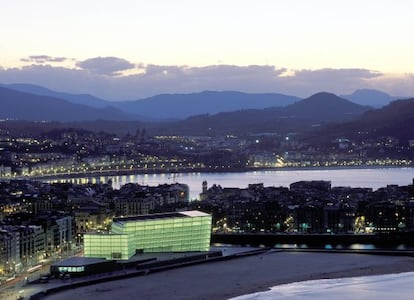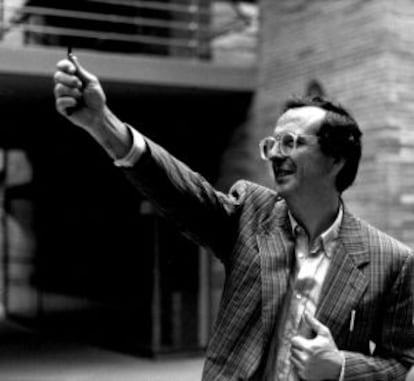Settling architectural scores
Spain's most honored architect, Rafael Moneo, is looking back over his career -- and taking a few swipes at his peers -- with a retrospective in A Coruña


"We architects should not cheat. Someone who has completed their professional project by misleading the user ends up a prisoner of their own naivety."
At the age of 76, Spanish architect Rafael Moneo is settling some scores. For the first time he is exhibiting the plans of all of his buildings together: from the Museum of Roman Art in Mérida (1985) and the Kursaal Congress Center and Auditorium in San Sebastián (1999), to the new Torre Puig skyscraper in Barcelona, the Los Angeles Cathedral (2002) and the Beirut Souks shopping center (2010). The show, which is on at the Fundación Barrié in A Coruña until March 30 under the title Una reflexión teórica desde la profesión (A theoretical reflection from inside the profession), is leading him to talk about responsibility, the city and the work of other architects almost as much as his own.
Moneo has always criticized isolated buildings that don't fit into the common project that is a city. In this show, he calls for a reflection on the priorities of architects today. "At the start of the 20th century, Le Corbusier tried to assimilate new techniques with new languages," he says. "Today Zaha Hadid's undulating architecture is put forward as cutting edge while deliberately overlooking how it is going to be built."
Moneo's lesson is about how the works relate to place and history. He champions architecture as culture and knowledge: "I don't know how the cities of the Gulf function or how those in China are updated, but I suspect they will not improve upon the old-fashioned city," he says.
The 1996 Pritzker Prize winner is critical, for instance, of Renzo Piano's Shard skyscraper in London: "Piano has such a significant workload that he must be making multiple use of it, and in the end his new spire once again connects with that line in British architecture of not being able to abandon the Gothic."

He talks about other people's workloads as if it is something he has never suffered - or enjoyed - himself. Moneo has 30 employees, but says he has worked personally on all his projects. "And that is a limitation." He says he would have been another person "if I hadn't been distracted so much by other pursuits" — writing, thinking, teaching — and cites the example of Álvaro Siza, "who, free of teaching or writing, has a bigger volume of work than me." Moneo seems very demanding of Siza, whom he considers the "most talented living architect."
The curator of the exhibition, Francisco González de Canales, a lecturer at the Architectural Association School of Architecture in London, has selected key drawings that define Moneo's thought processes. "They let you see to what degree our professional practice no longer coincides with other practices. Drawing means less for Piano," says Moneo, pointing out that "Gothic builders did not work from plans. The drawing that helped you to think arrived with the Renaissance and lasted until the 20th century, when the computer transformed it into something else."
Asked how many of the exhibited drawings are his, he replies that he supervised them all and created half of them personally. He gets up and comes back with several notebooks: "I draw almost every day," he says.
The retrospective begins with one of those drawings, showing the Plaza del Obradoiro in Santiago de Compostela, which won him the Rome scholarship in 1962. The city has been key to his work - but what does that mean coming from a 21st-century architect? "Rome is the origin of Western culture. And that of a global culture." He explains that his architect colleagues widened their studies in America and "came back converted into urbanites," but his marriage to Belén Feduchi, a daughter and sister of architects, pushed him toward Rome.
Moneo says he doesn't feel part of that group of leading architects who share out the best commissions on the planet, though he isn't sure whether that is to his gain or loss. "Neither one thing nor the other. Certainly my lifestyle gives rise to a certain way of working. I have been able to read more and go to more concerts," he says.
Is he as demanding about his own work as he is about that of others? "I would like to be. I am less radical than Siza and I'm jealous of his radicalism," Moneo says. He hasn't suffered from not being a "brand name" architect like Frank Gehry or Siza, he adds. "I think I have honored architecture, while always fulfilling its ample obligations."
Rafael Moneo. Una reflexión teórica desde la profesión. Materiales de archivo (1961-2013) . Until March 30 at Fundación Barrié, Rúa Cantón Grande 9, A Coruña. www.fundacionbarrie.org
Tu suscripción se está usando en otro dispositivo
¿Quieres añadir otro usuario a tu suscripción?
Si continúas leyendo en este dispositivo, no se podrá leer en el otro.
FlechaTu suscripción se está usando en otro dispositivo y solo puedes acceder a EL PAÍS desde un dispositivo a la vez.
Si quieres compartir tu cuenta, cambia tu suscripción a la modalidad Premium, así podrás añadir otro usuario. Cada uno accederá con su propia cuenta de email, lo que os permitirá personalizar vuestra experiencia en EL PAÍS.
¿Tienes una suscripción de empresa? Accede aquí para contratar más cuentas.
En el caso de no saber quién está usando tu cuenta, te recomendamos cambiar tu contraseña aquí.
Si decides continuar compartiendo tu cuenta, este mensaje se mostrará en tu dispositivo y en el de la otra persona que está usando tu cuenta de forma indefinida, afectando a tu experiencia de lectura. Puedes consultar aquí los términos y condiciones de la suscripción digital.
Últimas noticias
From digital curfews to blocking apps: How technology experts protect their children online
Why the price of coffee has skyrocketed: from Brazilian plantations to specialty coffee houses
Confined to a Cuban hospital: When electricity is a matter of life or death
The complicated life of Francesca Albanese: A rising figure in Italy but barred from every bank by Trump’s sanctions
Most viewed
- Why we lost the habit of sleeping in two segments and how that changed our sense of time
- Trump’s obsession with putting his name on everything is unprecedented in the United States
- Pablo Escobar’s hippos: A serious environmental problem, 40 years on
- The Florida Keys tourist paradise is besieged by immigration agents: ‘We’ve never seen anything like this’
- Charles Dubouloz, mountaineering star, retires at 36 with a farewell tour inspired by Walter Bonatti








































